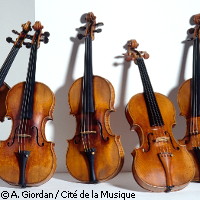Study reveals secret of Stradivari's varnishes
Stradivarius violins owe their great beauty to substances that were readily available and widely used by artists of the early 18th century, according to new EU-funded research published in the journal Angewandte Chemie International Edition. The findings lay to rest long-standing theories that the master instrument maker used rare or secret ingredients in his varnishes. 'He was simply a true master of his craft,' commented the lead author of the paper, Jean-Philippe Echard of the Musée de la Musique in Paris, France. EU support for the work came from the IA-SFS ('Integrating activity on synchrotron and free electron laser science'), which was funded under the 'Research infrastructures' budget line of the Sixth Framework Programme (FP6). Antonio Stradivari (1644-1737) is one of the most famous instrument makers of all time. From 1665 until his death, he produced violins and other stringed instruments of exceptional quality. The tone produced by his instruments is outstanding and continues to amaze audiences today. However, the tone is not the only thing that makes these fascinating instruments stand out - they are also extremely beautiful to look at. For centuries, experts have wondered what kind of varnishes Stradivari used; many have suggested that he must have used rare or even secret ingredients to obtain such a beautiful finish. In this latest study, a Franco-German team comprising scientists and violin makers studied five instruments (four violins and one viola d'amore, named, some say, for the carved blindfolded cupid's head it often sported) made by the great man. The instruments, which are housed in the Musée de la Musique, were made over a period of 30 years. The team took tiny samples of wood and varnish from carefully chosen areas of the instruments. The samples were subjected to a battery of tests, providing the researchers with unprecedented information on the composition of the different layers of varnish used. The analyses revealed that Stradivari used two layers of varnish: a simple drying oil that penetrates up to a tenth of a millimetre into the wood of the instrument and was probably used as a sealant, and an upper layer that lies above the wood and is made up of oil, pine resin and pigments. 'Although the five instruments were produced over a period of three decades, their varnishes are very similar,' explained Dr Echard. 'Stradivari first applied a layer of an oil comparable to the oils used by painters of the same epoch, without fillers or pigments, to seal the wood. We did not find a mineral-rich layer, as some earlier work suggests. The master violin-maker next applied a slightly tinted oil-resin layer.' The oldest instrument, the 'Long Pattern' violin, which dates from around 1692, did not appear to have any pigments in its outer varnish layer. However, the varnish on the 'Sarasate' violin, from 1724, contained vermillion. The research also allowed the identification of two additional types of red pigment in Stradivari's finishes: one that is probably made from the insect-based dye cochineal, and another made of iron oxides. By using different pigments, Stradivari was able to give a variety of tints to his instruments, the researchers suggest. These pigments were widely used by artists of the day. 'We have found that Stradivari employed common and easily available components that were commonly used among craftsmen and artists in the 18th century,' the team concludes. 'These conclusions are fundamental in re-establishing the historical status of Antonio Stradivari: he might not have possessed an unusual or 'secret' ingredient, but he was an outstandingly skilled craftsman who had mastered the art of violin making, and in particular wood finishing.'
Countries
Germany, France



